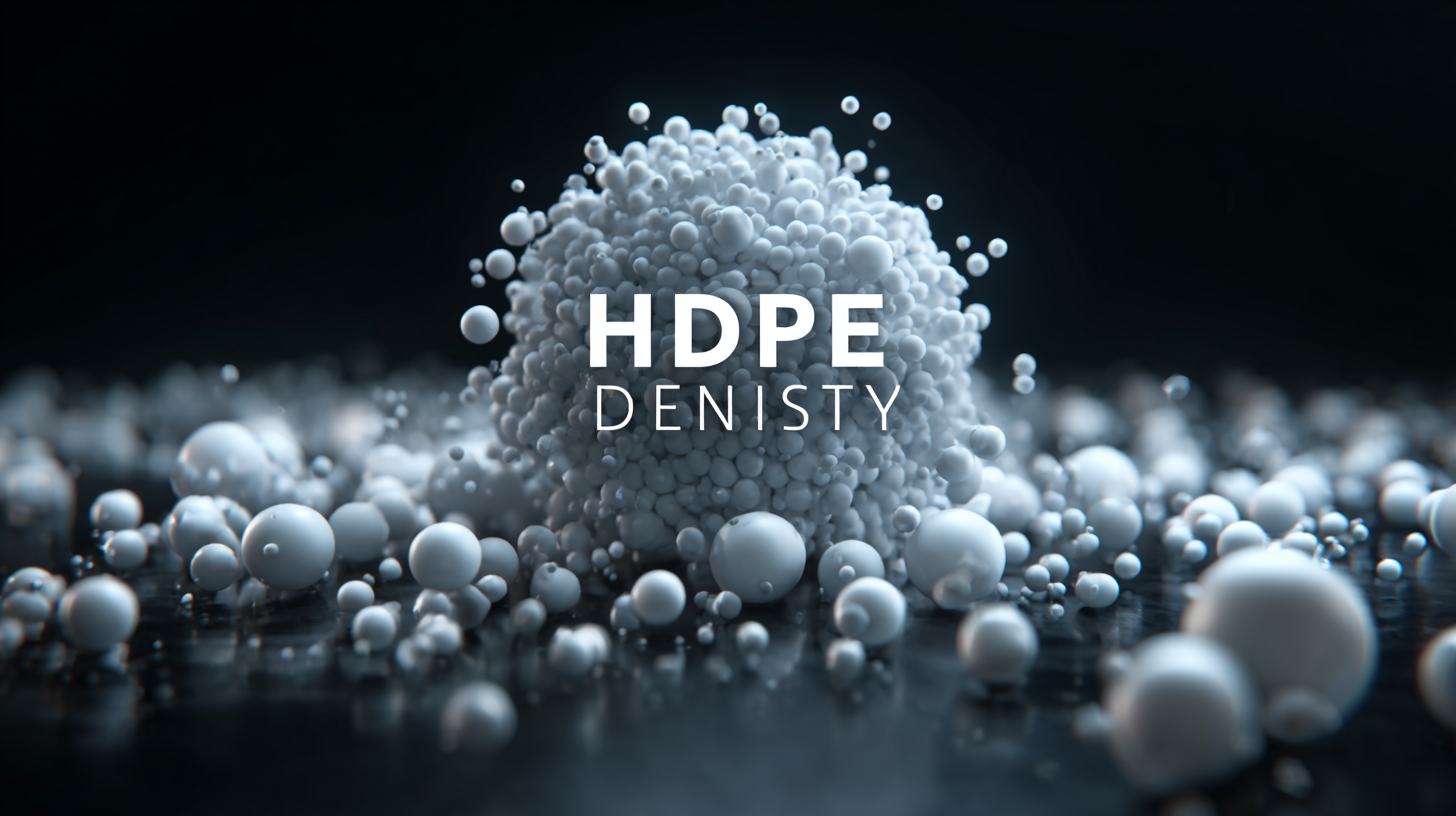Inquiry
Form loading...
- Phone
- E-mail
In the quest for optimized performance in various applications, understanding the nuances of HDPE density is crucial. High-density polyethylene (HDPE) stands out for its numerous advantages, including strength, durability, and chemical resistance. However, as industries evolve, the demand for innovative materials has prompted researchers to explore alternatives that maintain or exceed the remarkable properties of traditional HDPE. According to a recent market analysis by Smithers, the global HDPE market is projected to grow at a CAGR of 4.5% from 2021 to 2026, underscoring the material's enduring relevance. Conversely, emerging materials—whether composites or bio-based polymers—are being evaluated for their performance capabilities and environmental impacts. This blog post delves into a comparative analysis of these alternatives to best HDPE density, aiming to illuminate how they can enhance product performance while addressing sustainability concerns.

When it comes to enhancing performance in various applications, traditional high-density polyethylene (HDPE) often sets a benchmark. However, recent advancements in material science have opened the door to innovative alternatives that offer superior characteristics for specific needs. These alternatives not only enhance the overall durability but also contribute to sustainability in material usage. For instance, bio-based polymers derived from renewable resources present an eco-friendly option that does not compromise on strength or flexibility.
Moreover, engineers and designers are increasingly turning to composite materials that combine the beneficial properties of HDPE with other substances. For example, incorporating carbon nanotubes or glass fibers can significantly improve tensile strength and thermal stability. These hybrid materials are particularly useful in industries where high performance is essential, such as automotive and aerospace. As the demand for enhanced performance grows, exploring these innovative materials beyond traditional HDPE density is crucial for driving both efficiency and sustainability in modern manufacturing practices.

In the quest for enhanced performance in various applications, exploring alternatives to conventional HDPE density materials is becoming increasingly vital. Key factors influencing the performance of these alternative materials include their mechanical strength, environmental impact, and adaptability to specific use cases. For instance, recent studies on lightweight materials for automobiles have shown that high-strength steels and light alloys can offer improved durability while reducing overall vehicle weight.
When considering alternative materials, it's crucial to be aware of the environmental life cycle performance. Innovations in low cement ultra-high performance concrete, which utilizes ultrafine quartz powder, demonstrate how alternative substances can enhance mechanical strength under extreme conditions. As industries seek to minimize their carbon footprint, the integration of sustainable options, such as mushroom-derived proteins in aquafeeds or PFAS-free solutions, showcases the potential of bio-based materials.
Tips for selecting alternative materials include evaluating their long-term performance metrics, analyzing cost-effectiveness, and considering their environmental impact. Always prioritize materials that not only meet performance demands but also align with sustainability goals. By fostering a mindset that embraces innovation and ecological responsibility, industries can significantly enhance their operational efficiency and impact.
| Material Type | Density (g/cm³) | Tensile Strength (MPa) | Impact Resistance (J/m) | Thermal Stability (°C) |
|---|---|---|---|---|
| Polypropylene (PP) | 0.90 | 30 | 60 | 100 |
| Polyethylene Terephthalate (PET) | 1.38 | 55 | 80 | 80 |
| Acrylonitrile Butadiene Styrene (ABS) | 1.04 | 45 | 100 | 80 |
| Polyvinyl Chloride (PVC) | 1.40 | 50 | 70 | 60 |
| High-Density Polyethylene (HDPE) | 0.97 | 27 | 80 | 120 |
When evaluating HDPE (High-Density Polyethylene) and its alternatives, it is essential to conduct a comparative analysis to understand their respective strengths and weaknesses. Recent studies have revealed that reinforced soil beds using natural fibers like jute and sisal can outperform HDPE geocells in specific applications, particularly in construction and environmental sustainability. These natural fiber composites demonstrate excellent load-bearing capacity while being eco-friendly alternatives that reduce reliance on synthetic materials.
**Tips:** When considering alternatives, look for materials that offer similar strength with lower environmental impact. Natural fibers, as shown in recent research, can provide exceptional durability while promoting sustainability. Additionally, explore new composites made from recycled high-density polyethylene combined with other organic materials, as they can yield high-performance products suitable for various applications, such as automotive parts.
Moreover, the comparisons highlight the potential of composites originating from renewable resources. Such innovations not only provide a reduction in carbon footprint but also contribute to a circular economy. This shift towards more sustainable materials like those incorporating recycled content is a significant step forward in material science, offering practical solutions to industry demands while protecting our planet.
When it comes to sustainable practices in material selection, exploring alternatives to conventional high-density polyethylene (HDPE) can yield significant benefits for both performance and environmental impact. Innovative eco-friendly materials, such as bioplastics derived from cornstarch or bamboo, present a promising solution. These alternatives not only reduce reliance on fossil fuels but also offer biodegradability, supporting a circular economy.
Tips for selecting sustainable alternatives include conducting a life cycle assessment to evaluate the environmental impact of different materials. This can help identify options that minimize carbon footprints and waste. Additionally, consider the end-of-life potential of materials; choosing options that are compostable or recyclable can further enhance sustainability efforts.
It's also essential to look for certifications that indicate a product's eco-friendliness. Labels from recognized organizations can offer reassurance about the sustainability claims of materials. By integrating these practices into your material selection process, you can contribute to a healthier planet while still meeting performance requirements.

As material science continues to evolve, the exploration of alternatives to
high-density polyethylene (HDPE) is paving the way for
innovative solutions that enhance performance across various applications. Researchers are now
focusing on materials that not only match but exceed the properties of HDPE.
Biopolymers,
for instance, present a promising avenue, combining sustainability with impressive strength
and flexibility. With the rise of biodegradable options, industries can significantly reduce
their environmental footprint while maintaining product quality.
In addition, advancements in composite materials are reshaping our understanding of density
and performance. By integrating nanomaterials with traditional polymers, scientists are creating
composites that exhibit superior characteristics such as increased
durability, light weight, and
resistance to temperature extremes. These innovations indicate a future where material
performance is optimized, addressing the demands of both consumers and environmental challenges.
The shift toward these next-generation materials
suggests a transformative approach in design and manufacturing, ultimately leading to a
more sustainable and efficient use of resources.
